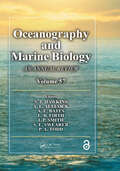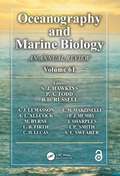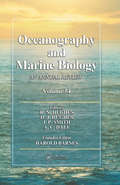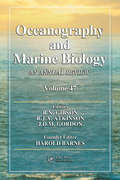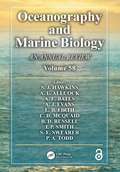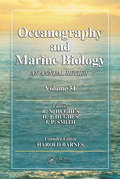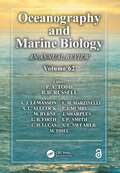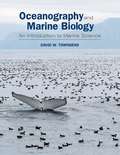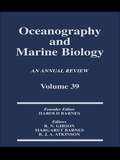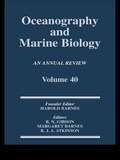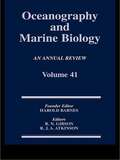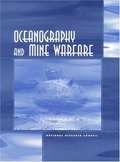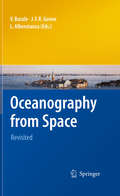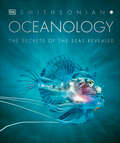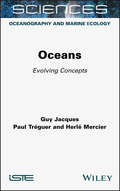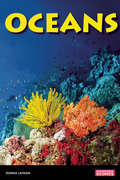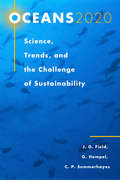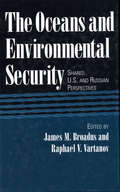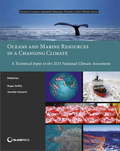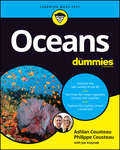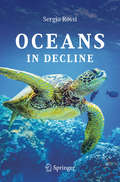- Table View
- List View
Oceanography and Marine Biology: An Annual Review, Volume 57 (Oceanography and Marine Biology - An Annual Review #57)
by S. J. Hawkins L. B. Firth I. P. Smith A. L. Allcock A. E. Bates S. E. Swearer P. A. ToddOceanography and Marine Biology: An Annual Review remains one of the most cited sources in marine science and oceanography. The ever increasing interest in work in oceanography and marine biology and its relevance to global environmental issues, especially global climate change and its impacts, creates a demand for authoritative reviews summarizing the results of recent research. This volume covers topics that include resting cysts from coastal marine plankton, facilitation cascades in marine ecosystems, and the way that human activities are rapidly altering the sensory landscape and behaviour of marine animals. Guidelines for contributors, including information on illustration requirements, can be downloaded on the Downloads/Updates tab on the books webpage. For more than 50 years, OMBAR has been an essential reference for research workers and students in all fields of marine science. From Volume 57 a new international Editorial Board ensures global relevance, with editors from the UK, Ireland, Canada, Australia and Singapore. The series volumes find a place in the libraries of not only marine laboratories and institutes, but also universities. Chapters, 1, 3 and 7 of this book are freely available as a downloadable Open Access PDF under a Creative Commons Attribution-Non Commercial-No Derivatives 4.0 license. The links can be found on the book's Routledge web page at https://www.routledge.com//9780367134150
Oceanography and Marine Biology: An annual review. Volume 61 (Oceanography and Marine Biology - An Annual Review #61)
by S. J. Hawkins P. A. Todd B. D. Russell A. J. Lemasson A. L. Allcock M. Byrne L. B. Firth C. H. Lucas E. M. Marzinelli P. J. Mumby J. Sharples I. P. Smith S. E. SwearerOceanography and Marine Biology: An Annual Review remains one of the most cited sources in marine science. The increasing interest in work in oceanography and marine biology and its relevance to global environmental issues, especially global climate change and its impacts, creates a demand for authoritative refereed reviews summarising and synthesising the results of both historical and recent research. For more than 50 years, OMBAR has been an essential reference for researchers, students and workers in all fields of marine science. An international Editorial Board ensures global relevance and expert peer review, with editors from Australia, Hong Kong, Ireland, Singapore, and the UK. The series of volumes can be found in the libraries of institutes and universities worldwide. Five of the seven peer-reviewed contributions in Volume 61 are available to read Open Access via this webpage and on OAPEN. Supplementary material is provided online on the Support Materials tab on the book’s www.routledge.com webpage for Reviews 1, 2, 4, 5 and 6.. Volume 61 features a review of 100 years of daily sea surface temperature from the Hopkins Marine Station in Pacific Grove, California; an exploration of the biology and life cycle of enigmatic crustacean y-larvae; a review of the science, policy and management of the Central and South Atlantic Deep Sea benthos; a review of the biodiversity of the Irish-Scottish continental margin; an investigation of how new molecular tools can be used for marine biodiversity and ecosystem assessments, and a look at the resilience of marine organisms to climate change. A final monograph considers enemy shells as refugia from grazing and competition pressure. If you are interested in submitting a review for consideration for publication in OMBAR, please email the new co-Editors in Chief, Dr Peter Todd (dbspat@nus.edu.sg) and Dr Bayden Russell (brussell@hku.hk). Guidelines for contributors to OMBAR, including information on illustration requirements, can be downloaded on the "Support Material" tab on the latest volume’s webpage.
Oceanography and Marine Biology: An annual review. Volume 52 (Oceanography and Marine Biology - An Annual Review)
by R. N. Hughes D. J. Hughes I. P. SmithEver-increasing interest in oceanography and marine biology and their relevance to global environmental issues creates a demand for authoritative reviews summarising the results of recent research. Oceanography and Marine Biology: An Annual Review has catered to this demand since its founding by the late Harold Barnes fifty years ago. Its objective
Oceanography and Marine Biology: An Annual Review, Volume 54 (Oceanography and Marine Biology - An Annual Review)
by R. N. Hughes D. J. Hughes I. P. Smith A. C. DaleEver-increasing interest in oceanography and marine biology and their relevance to global environmental issues create a demand for authoritative reviews summarizing the results of recent research. Oceanography and Marine Biology: An Annual Review has catered to this demand since its founding by the late Harold Barnes more than 50 years ago. Its objectives are to consider, annually, the basic areas of marine research, returning to them when appropriate in future volumes; to deal with subjects of special and topical importance; and to add new subjects as they arise. The favourable reception and complimentary reviews accorded to all the volumes shows that the series is fulfilling a very real need. Volume 54 follows closely the objectives and style of the earlier volumes, continuing to regard the marine sciences—with all their various aspects—as a unity. Physical, chemical, and biological aspects of marine science are dealt with by experts actively engaged in these fields. The series is an essential reference text for researchers and students in all fields of marine science and related subjects, and it finds a place in libraries of universities, marine laboratories, research institutes and government departments. It is consistently among the highest ranking series in terms of impact factor in the marine biology category of the citation indices compiled by the Institute for Scientific Information/Web of Science.
Oceanography and Marine Biology: An annual review. Volume 47 (Oceanography and Marine Biology - An Annual Review)
by Ian MuehlenhausReflecting increased interest in the field and its relevance in global environmental issues, Oceanography and Marine Biology: An Annual Review, Volume 47 provides authoritative reviews that summarize results of recent research in basic areas of marine research, exploring topics of special and topical importance while adding to new areas as they arise. This volume, part of a series that regards the all marine sciences as a complete unit, features contributions from experts involved in biological, chemical, geological, and physical aspects of marine science.
Oceanography and Marine Biology: An annual review. Volume 58 (Oceanography and Marine Biology - An Annual Review #58)
by S. J. Hawkins, A. L. Allcock, A. E. Bates, A. J. Evans, L. B. Firth, C. D. McQuaid, B. D. Russell, I. P. Smith, S. E. Swearer, and P. A. ToddOceanography and Marine Biology: An Annual Review remains one of the most cited sources in marine science and oceanography. The ever-increasing interest in work in oceanography and marine biology and its relevance to global environmental issues, especially global climate change and its impacts, creates a demand for authoritative refereed reviews summarizing and synthesizing the results of recent research. For more than 50 years, OMBAR has been an essential reference for research workers and students in all fields of marine science. If you are interested in submitting a review for consideration for publication in OMBAR, please email the Editor in Chief, Stephen Hawkins, at S.J.Hawkins@soton.ac.uk. This volume considers such diverse topics as optimal design for ecosystem-level ocean observatories, the oceanography and ecology of Ningaloo, human pressures and the emergence of novel marine ecosystems and priority species to support the functional integrity of coral reefs. Six of the nine peer-reviewed contributions in Volume 58 are available to read Open Access via the links on the Routledge.com webpage. An international Editorial Board ensures global relevance and expert peer review, with editors from Australia, Canada, Hong Kong, Ireland, Singapore, South Africa and the United Kingdom. The series volumes find a place in the libraries of not only marine laboratories and oceanographic institutes, but also universities worldwide. Chapters 1, 2, 3, 4, 5, 7, and 8 of this book are freely available as downloadable Open Access PDFs at http://www.taylorfrancis.com under a Creative Commons Attribution-Non Commercial-No Derivatives (CC-BY-NC-ND) 4.0 license.
Oceanography and Marine Biology: An annual review. Volume 51 (ISSN)
by I. P. Smith R. N. Hughes D. J. HughesEver-increasing interest in oceanography and marine biology and their relevance to global environmental issues creates a demand for authoritative reviews summarising the results of recent research. Oceanography and Marine Biology: An Annual Review has catered to this demand since its founding by the late Harold Barnes fifty years ago. Its objective
Oceanography and Marine Biology: An Annual Review, Volume 62 (ISSN)
by P. A. Todd B. D. Russell A. J. Lemasson A. L. Allcock M. Byrne L. B. Firth C. H. Lucas E. M. Marzinelli P. J. Mumby J. Sharples I. P. Smith S. E. Swearer M. ThielOceanography and Marine Biology: An Annual Review remains one of the most cited sources in marine science and oceanography. The ever-increasing interest in work in oceanography and marine biology and its relevance to global environmental issues, especially global climate change and its impacts, creates a demand for authoritative refereed reviews summarising and synthesising the results of both historical and recent research.If you are interested in submitting a review for consideration for publication in OMBAR, please email the new co-Editors in Chief, Dr Peter Todd (dbspat@nus.edu.sg) and Dr Bayden Russell (brussell@hku.hk).Supplementary material is provided online on the Support Materials tab, for Reviews 2, 5, 6, 7, 8, 9 and 10.Volume 62 features a review of the biology, ecology and conservation threats to the Iberian harbour porpoise; a look at the potential risk to Mediterranean cetaceans and sea turtles from floating marine macro litter; an overview of the recent history and physical environment of corals in the Andaman Sea; an exploration of the population biology of Snapper fish in South Australia; and a review of historical killings of small cetaceans in the Northeast Atlantic and Mediterranean Sea, among others.An international Editorial Board ensures global relevance and expert peer review, with editors from Australia, Canada, Hong Kong, Ireland, Singapore and the UK. The series volumes find a place in the libraries of not only marine laboratories and oceanographic institutes but also universities worldwide. Chapters 1, 2, 4, 6, 8 and 9 of this volume are freely available as a downloadable Open Access PDF at http://www.taylorfrancis.com under a Creative Commons [Attribution-Non Commercial-No Derivatives (CC-BY-NC-ND)] 4.0 license.
Oceanography and Marine Biology: An Introduction to Marine Science
by David W. TownsendOceanography and Marine Biology preserves the basic elements of the physical, chemical, and geological aspects of the marine sciences, and merges those fundamentals into a broader framework of marine biology and ecology. Existing textbooks on oceanography or marine biology address the companion field only cursorily: very few pages in oceanography texts are devoted to marine biology, and vice versa. This new book overcomes that imbalance, bringing these disparate marine science text formats closer together, giving them more equal weight, and introducing more effectively the physical sciences by showing students with everyday examples how such concepts form the foundation upon which to build a better understanding of the marine environment in a changing world. Lecturer supplements will also be available.
Oceanography and Marine Biology, An Annual Review, Volume 39: An Annual Review: Volume 39 (Oceanography And Marine Biology - An Annual Review Ser.)
by R. N. Gibson Margaret Barnes R. J. A. AtkinsonInterest in oceanography and marine biology and the relevance of those fields to global environmental issues creates a demand for authoritative reviews that summarize recent research. Oceanography and Marine Biology: an Annual Review has catered to this demand since its foundation, by the late Harold Barnes, more than 35 years ago. It is an annual
Oceanography and Marine Biology, An Annual Review, Volume 40: An Annual Review: Volume 40 (Oceanography And Marine Biology - An Annual Review Ser.)
by R. N. Gibson Margaret Barnes R. J. A. Atkinson Harold BarnesInterest in oceanography and marine biology and its relevance to global environmental issues continues to increase, creating a demand for authoritative reviews that summarize recent research. Oceanography and Marine Biology: An Annual Review has catered to this demand since its foundation, by the late Harold Barnes, more than 40 years ago. It is an
Oceanography and Marine Biology, An Annual Review, Volume 41: An Annual Review: Volume 41 (Oceanography And Marine Biology - An Annual Review Ser. #Vol. 41)
by R. N. Gibson R. J. A. AtkinsonInterest in oceanography and marine biology and its relevance to global environmental issues continues to increase, creating a demand for authoritative reviews that summarize recent research. Oceanography and Marine Biology: An Annual Review has catered to this demand since its foundation, by the late Harold Barnes, more than 40 years ago. It is an
Oceanography and Marine Biology: An Annual Review, Volume 60 (Oceanography and Marine Biology - An Annual Review #60)
by S. J. HawkinsOceanography and Marine Biology: An Annual Review remains one of the most cited sources in marine science and oceanography. The ever-increasing interest in work in oceanography and marine biology and its relevance to global environmental issues, especially global climate change and its impacts, creates a demand for authoritative refereed reviews summarizing and synthesizing the results of both historical and recent research. This Volume celebrates 60 years of OMBAR, over which time it has been an essential reference for research workers and students in all fields of marine science. The peer-reviewed contributions in Volume 60 are available to read Open Access via this webpage and on OAPEN. If you are interested in submitting a review for consideration for publication in OMBAR, please email the Editor-in-Chief, Stephen Hawkins (S.J.Hawkins@soton.ac.uk) for Volume 61. For Volume 62 onwards, please email the new co-Editors in Chief, Dr Peter Todd (dbspat@nus.edu.sg) and Dr Bayden Russell (brussell@hku.hk). Volume 60 features an editorial on the UN Decade of Ocean Science and goes on to consider such diverse topics as Cenozoic tropical marine biodiversity, blue carbon ecosystems in Sri Lanka, marine litter and microplastics in the Western Indian Ocean, and the ecology and conservation status of the family Syngnathidae in southern and western Africa. This volume also contains a retrospective Prologue on the evolution of OMBAR and pays tribute to one of its early Editors in Chief, Margaret Barnes, by providing an update on her review in OMBAR of the stalked barnacle Pollicipes. Supplementary online videos as well as additional Tables and Appendices are available on the Support Tab of the book's Routledge webpage. An international Editorial Board ensures global relevance and expert peer review, with editors from Australia, Canada, Hong Kong, Ireland, Singapore and the UK. The series volumes find a place in the libraries of not only marine laboratories and oceanographic institutes, but also universities worldwide.
Oceanography And Mine Warfare
by National Research CouncilBased on a 1999 symposium, this report reviews how oceanographic data are used in US mine warfare, and the current and future capability of research to enhance such operations. Coverage includes doctrine, training issues, data collection/database capabilities, and modeling capabilities. Appends information on the symposium, a wargame scenario, the Office of Naval Research Program, and supporting research programs. Lacks an index. Annotation c. Book News, Inc. , Portland, OR (booknews. com)
Oceanography from Space
by J.F.R. Gower L. Alberotanza Vittorio BaraleThis Volume collects a series of key-note lectures delivered at the fourth "Oceans from Space" Symposium, held in Venice, Italy, in 2010. The revisited postscript in the title identifies it as the ideal follow-up of the legendary Oceanography from Space, edited by J.F.R. Gower and published in 1980, following the very first edition of "Oceans from Space". This series of conferences, which are held every 10 years only, is designed as a periodical state-of-the-art review of satellite oceanography, providing both an outline of current research, as well as a forum to debate topical issues. The "Oceans from Space" Venice 2010 lectures, authored by a unique group of prominent scientists, address virtually every facet of oceanographic remote sensing. All salient marine applications of passive and active techniques are covered in the present collection. The main results already achieved, or soon to come, demonstrate the potential of Earth Observations to help explore the dynamical and bio-geo-chemical features of the World's Oceans. V. BARALE graduated in Physics in 1977, from the University of Milan, and then received both his M.S., in 1982, and Ph.D., in 1986, at the Scripps Institution of Oceanography, from the University of California at San Diego. Since 1990 he has been with the Joint Research Centre of the European Commission. His research focuses on the ecological assessment of marginal and enclosed (European) seas, using optical remote sensing. J.F.R. GOWER received his Ph.D. in Radio Astronomy in 1966 at the University of Cambridge, England, after graduating in Natural Sciences from the same University in 1962. He moved to Canada and joined the University of British Columbia in 1967. Since 1971 he has been at the Institute of Ocean Sciences, where he worked on optical, SAR and altimeter satellite data. He originated the "Oceans from Space" Conference series. L. ALBEROTANZA graduated in Geology in 1969 at the University of Padova. His career developed at the Consiglio Nazionale delle Ricerche (CNR), in Venice, where he has done research on optical remote sensing of marine, coastal and lagoon areas. He has been Director of the Venice CNR Institute, Professor at the University of Venice, and is now President of the Venice City Council Tidal Forecasting and Early Warning Centre.
Oceanology: The Secrets of the Sea Revealed (DK Secret World Encyclopedias)
by DKDive into this uniquely elegant visual exploration of the sea An informative and utterly beautiful introduction to marine life and the ocean environment, Oceanology brings the riches of the underwater world onto the printed page.Astounding photography reveals an abundance of life, from microscopic plankton to great whales, seaweed to starfish. Published in association with the Smithsonian Institution, the book explores every corner of the oceans, from coral reefs and mangrove swamps to deep ocean trenches. Along the way, and with the help of clear, simple illustrations, it explains how life has adapted to the marine environment, revealing for example how a stonefish delivers its lethal venom and how a sponge sustains itself by sifting food from passing currents. It also examines the physical forces and processes that shape the oceans, from global circulation systems and tides to undersea volcanoes and tsunamis.To most of us, the marine world is out of reach. But with the help of photography and the latest technology, Oceanology brings us up close to animals, plants, and other living things that inhabit a fantastic and almost incomprehensibly beautiful other dimension.
Oceans (Delta Science Readers)
by Delta EducationSalty ocean water covers about 71 percent of Earth's surface. Earth's four main oceans are the Pacific, the Atlantic, the Indian, and the Arctic. <P><P>The Pacific Ocean is so big that all the land on Earth could fit into it easily. The Arctic Ocean is the smallest ocean. But it is still bigger than the United States. All of Earth's oceans are connected. Water can move from one ocean into another. Together the four oceans make up one big world ocean. <P><P> The word sea is used to describe a smaller part of an ocean. The Caribbean Sea is off the southeastern coast of the United States. This sea is part of the Atlantic Ocean.
Oceans: Evolving Concepts (Ioc Ocean Forum Ser.)
by Guy Jacques Paul Tréguer Herlé MercierSince the HMS Challenger expedition of 1872–1876, our vision of the ocean has changed completely. We now understand that it plays a key role in biodiversity, climate regulation, and mineral and biological resources, and as such, the ocean is a major service provider for humanity. Oceans draws on data from new oceanographic and satellite tools, acquired through international interdisciplinary programs. It describes the processes that control how the ocean functions, on different spatial and temporal scales. After considering the evolution of concepts in physical, chemical and biological oceanography, the book outlines the future of a warmer, acidified, less oxygenated ocean. It shows how a view of the ocean at different scales changes how we understand it. Finally, the book presents the challenges facing the ocean in terms of the exploitation of biological and mineral resources, in the context of sustainable development and the regulation of climate change.
Oceans
by Donna LathamInvestigating the planet's biomes and examining the modern threats to each ecosystem, this interactive series challenges young readers to look at how their own actions affect the planet's health. With compare-and-contrast facts and vocabulary-building sidebars, each engaging guide reveals how environmental threats-both human and natural-affect plants and animals.Detailing the largest biome, this guide surveys the environmental threats to the earth's oceans. Teaching students about coral reefs-the rainforests of the ocean-this educational resource explores topics such as the connection between increasing levels of carbon dioxide in the atmosphere and the bleaching of the reefs. By comparing the size of an island of floating plastic and other trash in the middle of the Pacific Ocean to the state of Texas-and how that floating island impacts ocean life-the guide shows young environmentalists why consuming less plastic is important.
The Oceans: A Deep History
by Eelco J. RohlingThe 4.4-billion-year history of the oceans and their role in Earth's climate systemIt has often been said that we know more about the moon than we do about our own oceans. In fact, we know a great deal more about the oceans than many people realize. Scientists know that our actions today are shaping the oceans and climate of tomorrow—and that if we continue to act recklessly, the consequences will be dire. In this timely and accessible book, Eelco Rohling traces the 4.4 billion-year history of Earth’s oceans while also shedding light on the critical role they play in our planet’s climate system.Beginning with the formation of primeval Earth and the earliest appearance of oceans, Rohling takes readers on a journey through prehistory to the present age, vividly describing the major events in the ocean’s evolution—from snowball and greenhouse Earth to the end-Permian mass extinction, the breakup of the Pangaea supercontinent, and the changing climate of today. Along the way, he explores the close interrelationships of the oceans, climate, solid Earth processes, and life, using the context of Earth and ocean history to provide perspective on humankind’s impacts on the health and habitability of our planet—and on what the future may hold for us.An invaluable introduction to the cutting-edge science of paleoceanography, The Oceans enables you to make your own informed opinions about the environmental challenges we face as a result of humanity’s unrelenting drive to exploit the world ocean and its vital resources.
Oceans 2020: Science, Trends, and the Challenge of Sustainability
by John G. Field Colin P. Summerhayes Gotthilf HempelOceans 2020 presents a comprehensive assessment of the most important science and societal issues that are likely to arise in marine science and ocean management in the next twenty years. Sponsored by the Intergovernmental Oceanographic Commission (IOC), the Scientific Committee on Oceanic Research (SCOR), and the Scientific Committee on Problems of the Environment (SCOPE), the book brings together the world's leading ocean scientists and researchers to analyze the state of marine science and technology, identify key scientific issues for sustainable development, and evaluate the capability of scientists, governments, and private-sector stakeholders to respond to those issues. Topics include: basic ocean sciences; pressures on the coastal zone; climate change and the ocean; fisheries and fishery science in their search for sustainability; offshore industries including oil drilling, carbon sequestration, and manganese nodule mining; and marine information for shipping and defense. Also included are chapters on cross-cutting issues including operational oceanography, ocean instrumentation and technology, developing frameworks for cooperation, and capacity building in developing nations. In addition, the book offers an introductory overview and a "Vision to 2020" that outlines a path to rational ocean governance. In each chapter, contributors give a brief but comprehensive overview of the subject and then consider what has been achieved in recent years, define the problems, outline solutions, and set forth recommendations on the needs for and directions of ocean science in support of sustainable development for the next twenty years.Oceans 2020 suggests what can be done about major marine environmental issues through the better development and application of marine science and technology, focusing on the issues that are most closely related to human and sustainable development.
The Oceans and Environmental Security: Shared U.S. And Russian Perspectives
by Raphael V. Vartanov Suzanne M. Demisch Artemy A. Saguirian Tom Tietenburg James Broadus Matthew J. LamourieThe concept of environmental security, drawing on the widely understood notion of international strategic interdependence (in facing, for example, threats of nuclear war or economic collapse) is gaining currency as a way of thinking about international environmental management.In 1989, the Institute for World Economy and International Relations of the Russian Academy of Sciences and the Marine Policy Center of Woods Hole Oceanographic Institution instituted a joint project to examine environmental security as it applies to the world's oceans. The Oceans and Environmental Security is a unified expression of their findings.The oceans, as global commons, are of central importance to issues of international environmental security. Critical problems are those that are likely to destabilize normal relations between nations and provoke international countermeasures. As such, the book focuses on seven specific concerns: land-based marine pollution North Pacific fisheries depletion hazardous materials transport nuclear contamination the Arctic Ocean the Southern Ocean and Antarctica the Law of the Sea
Oceans and Marine Resources in a Changing Climate
by Roger Griffis Jennifer HowardPrepared for the 2013 National Climate Assessment and a landmark study in terms of its breadth and depth of coverage, Oceans and Marine Resources in a Changing Climate is the result of a collaboration among numerous local, state, federal, and nongovernmental agencies to develop a comprehensive, state of the art look at the effects of climate change on the oceans and marine ecosystems under U. S. jurisdiction. This book provides an assessment of scientific knowledge of the current and projected impacts of climate change and ocean acidification on the physical, chemical, and biological components and human uses of marine ecosystems under U. S. jurisdiction. It also provides assessment of the international implications for the U. S. due to climate impacts on ocean ecosystems and of efforts to prepare for and adapt to climate and acidification impacts on ocean ecosystem, including · Climate-Driven Physical and Chemical Changes in Marine Ecosystems · Impacts of Climate Change on Marine Organisms · Impacts of Climate Change on Human Uses of the Ocean · International Implications of Climate Change · Ocean Management Challenges, Adaptation Approaches, and Opportunities in a Changing Climate · Sustaining the Assessment of Climate Impacts on Oceans and Marine Resources Rich in science and case studies, it examines the latest climate change impacts, scenarios, vulnerabilities, and adaptive capacity and offers decision makers and stakeholders a substantial basis from which to make informed choices that will affect the well-being of the region's inhabitants in the decades to come.
Oceans For Dummies
by Ashlan Cousteau Philippe Cousteau Joseph KraynakDive deep to explore the ocean From how most of our oxygen is created by phytoplankton, to how currents control our climate, to the marine food chain and the importance of coral, this is the holy grail of ocean books that’s easy for everyone to digest. It features fun facts about some of the most incredible, bizarre, and fascinating creatures in the ocean, from mantis shrimp that can strike things with the speed of a .22 caliber bullet to fish with clear heads that can see out of the top of their skulls. The ocean is full of wonders and there is still so much left to explore and understand. How our oceans work What creatures live in the ocean Find out how the ocean regulates our climate and weather patterns How growing pollution threatens our ocean and its inhabitants Oceans For Dummies is perfect for anyone with an interest in the ocean, including kids, adults, students, ocean lovers, surfers, fishermen, conservationists, sailors, and everyone in between.
Oceans in Decline
by Sergio RossiWhat is happening in our oceans? By describing their main elements, this book shows how and why the oceans are being transformed, and suggests possible future scenarios to address this complex, yet often-asked, question. The ocean is being dramatically transformed, but the magnitude of this transformation remains unclear since the ocean is largely inaccessible and still unknown: there is more information about the outer universe than about the deepest parts of our oceans. The author, a marine biologist with extensive research experience, offers a holistic view of our oceans. Focusing on fishing, pollution and the effects of climate change, he identifies and describes the changes occurring in all marine ecosystems, and discusses the long-passed state of equilibrium.
